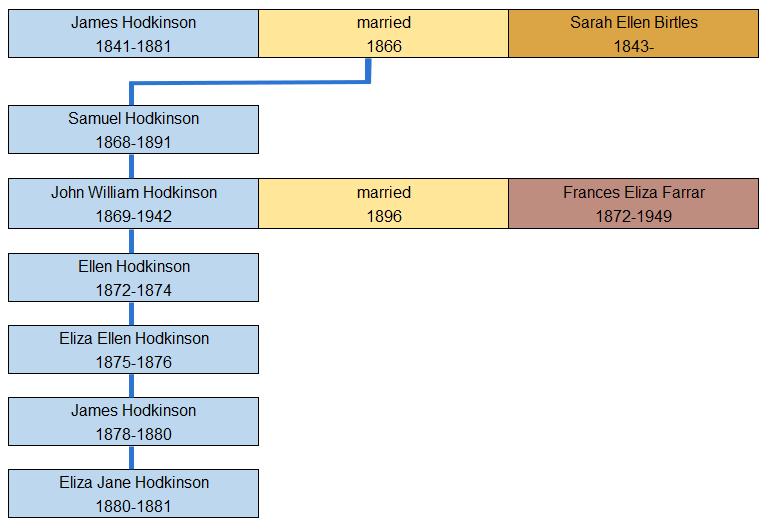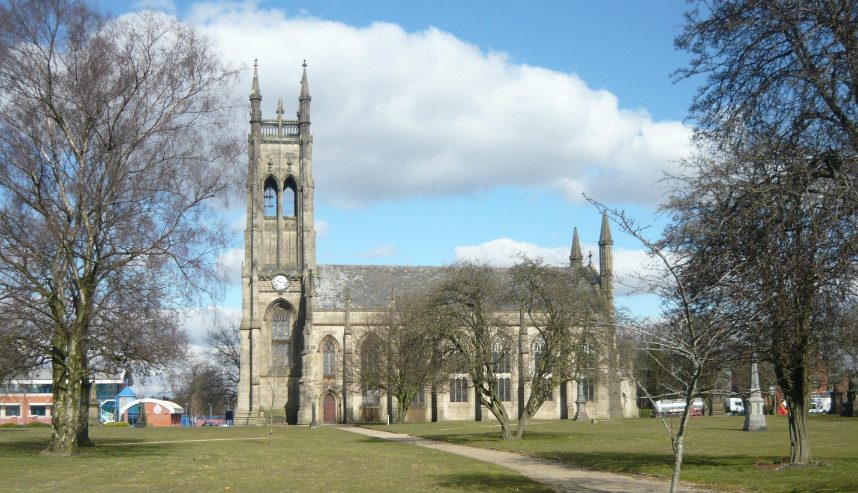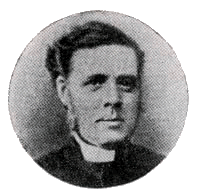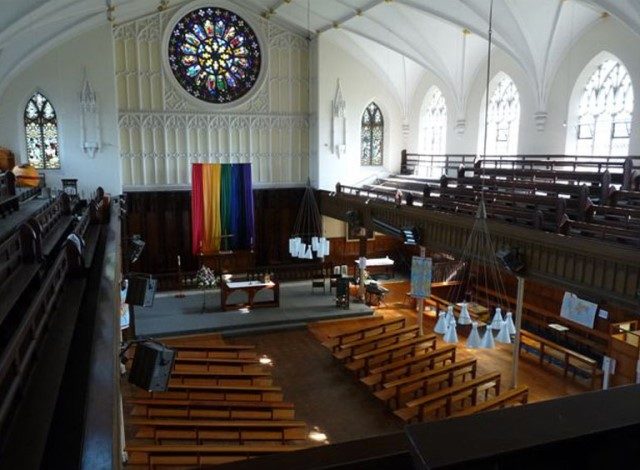1868–1891 Samuel Hodkinson
Samuel Hodkinson1
- Parents: James and Sarah Ellen Hodkinson
- Born: Saturday, 7th March 18681
- Never married
- No children
- Died: Tuesday, 2nd June 1891 (age 23 years and 2 months)
Samuel Hodkinson's immediate family
The first Saturday in March 1868 was a momentous day for Manchester-born 23-year-old Sarah Ellen Hodkinson and Stockport-born 27-year-old James Hodkinson with the arrival of their first child, Samuel. He was born in a small terraced house at 185 Church Street, Ashton-under-Lyne. The registration district was Ashton Town where there were about 1,000 births in the year of his birth.
Samuel Hodkinson's baptism at St Peter’s Church, Ashton-under-Lyne, on Sunday, 27th December 1868
On Sunday, 27th December 1868 the three members of the Hodkinson family – father James Hodkinson, mother Sarah Ellen Hodkinson, and nine-month-old Samuel Hodkinson – made the short walk from their home at 185 Church Street to St Peter’s Church.
December 1868 had seen a lot of rainfall, but temperatures were higher than normal for that time of year, so the journey to the church may have been wet, but not unduly cold.
Both parents had been brought up as members of the Church of England. They had, however, waivered in their commitment and when they married it was as members of the Methodist New Connexion. At some point after that ceremony, they ended their ties with the Methodist New Connexion and, two years and two days after the marriage, the next significant ceremony in their lives was the christening of their first-born child in their local parish church.
The christening was taken by the fourth incumbent of St. Peter’s, the Reverend William Ogden, a well-liked and powerful preacher who could draw in large congregations. He originated from Elland, near Leeds and he was about 38 years old when he baptised Samuel.
Christenings normally took place before the morning service and it may be that the Hodkinsons remained at the church for the regular service. If no-one had taken nine-month-old Samuel home, he would have found it to be a long morning. In those circumstances maybe he was a credit to his parents or maybe they spent the service longing for the time when they could take Samuel out of the building.
Inside the church
A long poem about the church was published in 1883, written by the Reverend W.B. Kirk,2 who succeeded William Ogden. The verses are of dubious quality, but the following selection gives a contemporary description of the interior of the building, one that the Hodkinsons would have been familiar with.
The church is high, and long, and wide.
As plain as plain can be;
No decorations meet the eye.
There's no art here to see.
Some pews are oblong and some square;
The pulpit's carved with taste;
The desks at each side used for prayer
Are pretty and well placed.
Additionally, the Reverend Kirk also wrote verses about the services held there. As ex-members of the Methodist New Connexion, maybe it was the evangelical nature of worship that drew the Hodkinsons to this particular church as well as its location so near to their home.
The services in this Church
Are Evangelical,
Though singing Creed and Psalms
And every Canticle.
We have no genuflexions.
No turning to the East,
No Ritualistic teaching,
And no intoning priest.
The Reverend W.B. Kirk commented about all aspects of the church, including the size of congregations.
Large numbers every Sunday
In this Church we see,
And on certain occasions
It's full as it can be.
Twill hold two thousand people
Quite comfortably;
The seats below are rented,
The galleries are free.
The galleries, as the Reverend Kirk pointed out, were free and it was here that the Hodkinsons would have sat when attending regular services.
St Peter’s Church was built between 1821 and 1824. This modern interior differs in a number of ways from the one with which the Hodkinsons were familiar – for example, the Victorian box pews and other furnishings have long since been removed.
Samuel Hodkinson's life from baptism to the early 1880s
There are three sections dealing with the shared lives of Samuel and his brother John William, which can be found here.
Samuel Hodkinson at work
Samuel Hodkinson, hawker
The 1891 census states that Samuel Hodkinson was a 'hawker', the only Hodkinson in this branch of the family recorded as having held this kind of job. Nowadays, the word ‘hawker’ is rarely used, but in Victorian times it was part of standard vocabulary and laws were passed – as they had been for centuries previously – to regulate their activities. One of the features of the laws passed in the late nineteenth century was that a distinction was made between pedlars and hawkers. In essence, a pedlar travelled by foot and a hawker was defined under an 1888 Act as anyone who travelled with a horse of other beast of burden selling goods. Hawkers also had to have a licence to sell.5
The reality is that Samuel most likely did not have a 'beast of burden' and would not have been interested in getting a licence. Samuel was probably a pedlar.
More conjecture has to be made as to why Samuel gave up being a hawker or pedlar and went back to working in a cotton factory. The two working environments were very different. The heat, noise, dust and the strongly regulated regime in a factory contrasted with a more independent, open-air life style, albeit often subject to other adverse working conditions.
Pedlars and hawkers could be successful, but they needed a variety of good retail skills, including market knowledge and the ability to negotiate good prices. Those who had poor retail skills barely scraped a living and Samuel Hodkinson may simply have been bad at what he was doing, which led him to change his job. Factory conditions were tough and often dangerous, but there was often a regular wage to be had and being an employee had advantages over being an unsuccessful self-employed trader.
Samuel Hodkinson, weaver
It was during 1891 Samuel gave up his job as a 'hawker' and found work in the cotton industry. No doubt this was to contribute to his death at a young age.
The atmosphere in cotton factories was deliberately kept hot and humid which helped to lower the number of thread breakages in the manufacturing process. Factory owners maintained or enhanced the humidity by adding spray from pipes around the sides of mills or from overhead valves. Known as steaming, the effect on humidity was further increased by poor ventilation. By the 1880s the detrimental effects on health of the atmospheres in cotton factories had increasingly become a matter of public concern. Despite that, workers still sought employment in cotton factories, Samuel Hodkinson amongst them.
Samuel Hodkinson's last days
Sadly, Samuel's decision to go back to working in a cotton factory may have contributed to his death. Many cotton factory workers suffered from respiratory diseases, one of them being byssinosis. 'Byssinosis' was coined in 1877, but understanding and knowledge of the disease at that stage was at an elementary level. Rylander and Schlling comment that the symptoms show:
… different degrees of severity from light irritation in the nose and airways to severe dry cough and breathing difficulties… Continued airways inflammation over several years may develop into chronic bronchitis … The clinical picture would be one of chronic obstructive pulmonary disease… 6
The non-respiratory clinical effects of byssinosis are fever, joint pains, neurosensory effects, skin problems, intestinal disease, fatigue and headache. Samuel fell ill on Thursday, 28th May 1891 and endured six days of pain and misery before he died on Tuesday, 2nd June. Dr Robert Macpherson certified his death as being caused by bronchopneumonia, whose outward symptoms can include fever, coughing (including coughing up blood-streaked mucus), chest pain, chest congestion, chills, and difficulty with breathing – all of which are quite similar to the outward manifestations of byssinosis. If Samuel had byssinosis prior to his latest job in a cotton factory and had carried on working as a hawker, he may well have lived many more years before the disease manifested itself, if at all. Certainly, one conclusion that can be drawn is that, if there was an underlying medical problem, then Samuel's decision to work in a cotton factory after his move to Bower Row hastened his death and, whatever the medical term used to describe his illness, there is no doubt that Samuel's last days were horrible. On Wednesday, 3rd June, Samuel's death was formally registered by Registrar John Wilde.
With the passing of Samuel Hodkinson, one member of the Hodkinson/Kenyon family now had the surname of Hodkinson: this was John William.
The homes of Samuel Hodkinson
The known dates of Samuel's known homes are stated below. The current status of the homes reflects the latest date of updates, as at the bottom of this page.
More details of the homes above, including maps and photographs, can be found here.
Notes and sources for this page
- Unless otherwise mentioned, this page is based on copies of birth, marriage and death certificates; census returns; and family documents and related items including photographs which are the property of Samuel Hodkinson.
- Rev. W.B .Kirk, Poems On Ashton and Neighbourhood. (Manchester: John Heywood. 1883.) pp. 45, 48 and 49.
- www.tameside.gov.uk., Tameside Image Archive. (http://www.tameside.gov.uk/history/archive.php3. 15 June 2010.) Image t03200.
- www.tameside.gov.uk., Tameside Image Archive. (http://www.tameside.gov.uk/history/archive.php3. 15 June 2010.) Image t01271.
- legislation.gov.uk., The Pedlars Act 1871. (http://www.legislation.gov.uk/ukpga/Vict/34-35/96. 5 November 2012.)This Act defined a pedlar as: ... any hawker, pedlar, petty chapman, tinker, caster of metals, mender of chairs, or other person who, without any horse or other beast bearing or drawing burden, travels and trades on foot and goes from town to town or to other men’s houses, carrying to sell or exposing for sale any goods, wares, or merchandise, or procuring orders for goods, wares, or merchandise immediately to be delivered, or selling or offering for sale his skill in handicraft ... The Encyclopaedia Britannica, 1911 edition. Hawkers. (http://www.theodora.com/encyclopedia/index.html. 5 November 2012.) provides this information: In 1888, the Hawkers Act defined a hawker as … anyone who travels with a horse or other beast of burden, selling goods ... This act stipulated that all hawkers were to be licensed, but licences would be dependent on the production of a certificate signed by a clergyman and two householders attesting that the person was of good character and a proper person to be licensed as a hawker.
- R. Rylander and R.S.F.Schlling, Safework Bookshelf. (www.ilo.org/safework_bookshelf/english?content&nd=857170101. 12 August 2010.)
This page was originally published in August 2010 with the latest revisions made on 23rd July 2024. Someday, it will be perfect!





